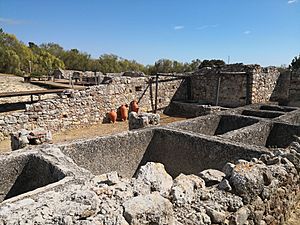Roman ruins of Tróia facts for kids
|
Ruínas Romanas de Tróia
|
|

Fish-processing tanks
|
|
| Location | Tróia Peninsula, Setúbal District, Portugal |
|---|---|
| Coordinates | 38°29′10″N 8°53′06″W / 38.486121°N 8.884947°W |
| Type | Ruins from the Roman Empire |
| Site notes | |
| Discovered | 16th century |
| Excavation dates | 1850; 1948; 1967; ongoing |
| Archaeologists | Inês Vaz Pinto |
| Condition | Fair |
| Public access | Yes |
The Roman ruins of Tróia are an amazing ancient site in Portugal. They are located on the Tróia Peninsula, right across from the city of Setúbal. These ruins show us what life was like between the 1st and 6th centuries CE. People here were very busy processing fish! The site also has old bathhouses and burial grounds. Since 1910, these ruins have been a special Portuguese National Monument.
Contents
Where Are the Tróia Ruins?
This ancient Roman site sits on a sandy peninsula. This land separates the Sado River estuary (where the river meets the sea) from the Atlantic Ocean. Back in Roman times, Tróia might have even been an island! The Sado River area was full of fish and salt. This made it perfect for creating a huge fish industry.
Tróia became one of the most important places in the Roman Empire for making fish products. They made salted fish, pickled fish, and a famous fish sauce called garum. These products were traded all over the Roman Empire. They were stored in special clay jars called amphorae. Another nearby site, the Roman ruins of Creiro, also processed fish.
What Was Found at Tróia?
The Tróia archaeological site has buildings and structures from the 1st to the 6th century CE. Archaeologists have found homes for both workers and factory owners. They also found 25 different workshops. These workshops had a total of 182 square tanks for processing fish. The biggest workshop was over 1,000 square meters. It had 19 tanks! Even the smallest workshop was 135 square meters and had 9 tanks. Items found here include large storage jars called dolia, amphorae, and fancy pottery called terra sigillata.
Roman Baths and Daily Life
Besides the workshops, archaeologists found large public baths. These baths covered an area of 450 square meters. They had different rooms for bathing:
- An apodyterium was a changing room.
- A frigidarium was a cold bath.
- A tepidarium was a warm bath.
- A caldarium was a hot bath. This room had an amazing underground heating system!
The complex also had swimming pools and a room for exercise.
Burial Grounds and Beliefs
The site also has four different burial areas. One was a mausoleum, which is a large tomb. There was also a columbarium. This was a building with many small niches (like shelves) in the walls. These niches were used to hold urns, which contained the ashes of people who had been cremated.
Archaeologists also found graves that seem to be Christian. These date from the late 5th century CE. There was even an early Christian church, called a paleochristian basilica. It was built in the late 4th or early 5th century, on top of an old, unused workshop. Inside this church, a marble carving dedicated to a god named Mithra was found. This suggests the building might have been used for a different religion before it became a Christian church. These different burial styles and religious findings show how long people lived here. They also show how religious beliefs changed over time.
Exploring the Past: Archaeology at Tróia
People first wrote about the Tróia ruins in the 16th century. But serious digging didn't start until the 18th century. Queen D. Maria I (when she was still a princess) led some of the first studies. In 1850, more excavations began. This was thanks to a group called the Lusitanian Archaeological Society. They worked in an area called the Casas da Princesa (Houses of the Princess). Here, they found walls with paintings and floors with beautiful mosaics.
More recently, big excavation projects happened between 1948 and 1967. During these digs, the baths, fish-salting houses, burial sites, and the early Christian church were uncovered. These projects were carried out by the Portuguese National Museum of Archaeology and the Direção-Geral do Património Cultural. The most recent work has been paid for by a company called Tróia Resort. Archaeologist Inês Vaz Pinto has been in charge of this work. Today, the ancient site is very close to a large beach resort area.
See also
 In Spanish: Ruinas romanas de Troia para niños
In Spanish: Ruinas romanas de Troia para niños

